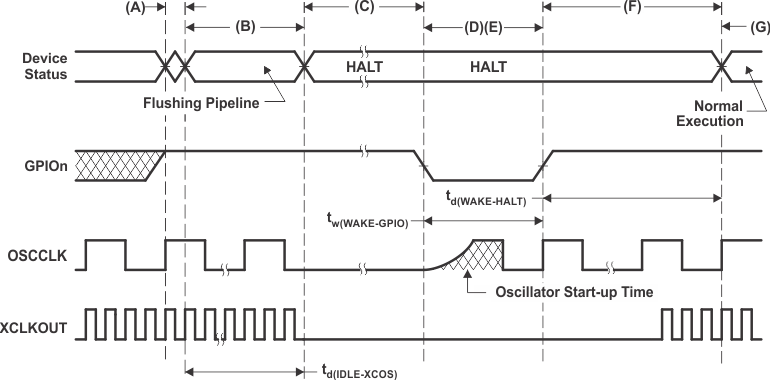SPRSP63B October 2022 – November 2023 TMS320F2800132 , TMS320F2800133 , TMS320F2800135 , TMS320F2800137
PRODUCTION DATA
- 1
- 1 Features
- 2 Applications
- 3 Description
- 4 Device Comparison
- 5 Pin Configuration and Functions
-
6 Specifications
- 6.1 Absolute Maximum Ratings
- 6.2 ESD Ratings
- 6.3 Recommended Operating Conditions
- 6.4 Power Consumption Summary
- 6.5 Electrical Characteristics
- 6.6 Thermal Resistance Characteristics for PM Package
- 6.7 Thermal Resistance Characteristics for PT Package
- 6.8 Thermal Resistance Characteristics for RGZ Package
- 6.9 Thermal Resistance Characteristics for RHB Package
- 6.10 Thermal Design Considerations
- 6.11
System
- 6.11.1
Power Management Module (PMM)
- 6.11.1.1 Introduction
- 6.11.1.2 Overview
- 6.11.1.3 External Components
- 6.11.1.4 Power Sequencing
- 6.11.1.5 Recommended Operating Conditions Applicability to the PMM
- 6.11.1.6 Power Management Module Electrical Data and Timing
- 6.11.2 Reset Timing
- 6.11.3
Clock Specifications
- 6.11.3.1 Clock Sources
- 6.11.3.2
Clock Frequencies, Requirements, and Characteristics
- 6.11.3.2.1
Input Clock Frequency and Timing
Requirements, PLL Lock Times
- 6.11.3.2.1.1 Input Clock Frequency
- 6.11.3.2.1.2 XTAL Oscillator Characteristics
- 6.11.3.2.1.3 X1 Input Level Characteristics When Using an External Clock Source - Not a Crystal
- 6.11.3.2.1.4 X1 Timing Requirements
- 6.11.3.2.1.5 AUXCLKIN Timing Requirements
- 6.11.3.2.1.6 APLL Characteristics
- 6.11.3.2.1.7 XCLKOUT Switching Characteristics - PLL Bypassed or Enabled
- 6.11.3.2.1.8 Internal Clock Frequencies
- 6.11.3.2.1
Input Clock Frequency and Timing
Requirements, PLL Lock Times
- 6.11.3.3 Input Clocks and PLLs
- 6.11.3.4 XTAL Oscillator
- 6.11.3.5 Internal Oscillators
- 6.11.4 Flash Parameters
- 6.11.5 RAM Specifications
- 6.11.6 ROM Specifications
- 6.11.7 Emulation/JTAG
- 6.11.8 GPIO Electrical Data and Timing
- 6.11.9 Interrupts
- 6.11.10
Low-Power Modes
- 6.11.10.1 Clock-Gating Low-Power Modes
- 6.11.10.2
Low-Power Mode Wake-up Timing
- 6.11.10.2.1 IDLE Mode Timing Requirements
- 6.11.10.2.2 IDLE Mode Switching Characteristics
- 6.11.10.2.3 IDLE Entry and Exit Timing Diagram
- 6.11.10.2.4 STANDBY Mode Timing Requirements
- 6.11.10.2.5 STANDBY Mode Switching Characteristics
- 6.11.10.2.6 STANDBY Entry and Exit Timing Diagram
- 6.11.10.2.7 HALT Mode Timing Requirements
- 6.11.10.2.8 HALT Mode Switching Characteristics
- 6.11.10.2.9 HALT Entry and Exit Timing Diagram
- 6.11.1
Power Management Module (PMM)
- 6.12
Analog Peripherals
- 6.12.1 Analog Pins and Internal Connections
- 6.12.2 Analog Signal Descriptions
- 6.12.3 Analog-to-Digital Converter (ADC)
- 6.12.4 Temperature Sensor
- 6.12.5
Comparator Subsystem (CMPSS)
- 6.12.5.1 CMPSS Module Variants
- 6.12.5.2 CMPx_DACL
- 6.12.5.3 CMPSS Connectivity Diagram
- 6.12.5.4 Block Diagrams
- 6.12.5.5
CMPSS Electrical Data and Timing
- 6.12.5.5.1 CMPSS Comparator Electrical Characteristics
- 6.12.5.5.2 CMPSS_LITE Comparator Electrical Characteristics
- CMPSS Comparator Input Referred Offset and Hysteresis
- 6.12.5.5.3 CMPSS DAC Static Electrical Characteristics
- 6.12.5.5.4 CMPSS_LITE DAC Static Electrical Characteristics
- 6.12.5.5.5 CMPSS Illustrative Graphs
- 6.12.5.5.6 CMPSS DAC Dynamic Error
- 6.12.5.5.7 Buffered Output from CMPx_DACL Operating Conditions
- 6.12.5.5.8 Buffered Output from CMPx_DACL Electrical Characteristics
- 6.13 Control Peripherals
- 6.14 Communications Peripherals
- 7 Detailed Description
- 8 Applications, Implementation, and Layout
- 9 Device and Documentation Support
- 10Revision History
- 11Mechanical, Packaging, and Orderable Information
Package Options
Refer to the PDF data sheet for device specific package drawings
Mechanical Data (Package|Pins)
- PM|64
- RGZ|48
- RHB|32
- PT|48
Thermal pad, mechanical data (Package|Pins)
Orderable Information
6.11.10.2.9 HALT Entry and Exit Timing Diagram

A. IDLE instruction is executed to put the device
into HALT mode.
B. The LPM block responds to the HALT signal, SYSCLK
is held for a maximum 16 INTOSC1 clock cycles
before being turned off. This delay enables the
CPU pipeline and any other pending operations to
flush properly.
C. Clocks to the peripherals are turned off and the PLL is shut down. If a quartz
crystal or ceramic resonator is used as the clock source, the internal
oscillator is shut down as well. The device is now in HALT mode and consumes
very little power. It is possible to keep the internal
oscillators (INTOSC1 and INTOSC2) and the watchdog alive in HALT MODE. This is
done by writing 1 to CLKSRCCTL1.WDHALTI. After the IDLE instruction is executed,
a delay of five OSCCLK cycles (minimum) is needed before the wake-up signal
could be asserted.
D. When the GPIOn pin (used to bring the device out
of HALT) is driven low, the oscillator is turned
on and the oscillator wake-up sequence is
initiated. The GPIO pin should be driven high only
after the oscillator has stabilized. This enables
the provision of a clean clock signal during the
PLL lock sequence. Because the falling edge of the
GPIO pin asynchronously begins the wake-up
procedure, care should be taken to maintain a low
noise environment before entering and during HALT
mode.
E. The wake-up signal fed to a GPIO pin to wake up
the device must meet the minimum pulse width
requirement. Furthermore, this signal must be free
of glitches. If a noisy signal is fed to a GPIO
pin, the wake-up behavior of the device will not
be deterministic and the device may not exit
low-power mode for subsequent wake-up
pulses.
F. When CLKIN to the core is enabled, the device
will respond to the interrupt (if enabled), after
some latency. The HALT mode is now exited.
G. Normal operation resumes.
H. The user must relock the PLL upon HALT wakeup to
ensure a stable PLL lock.
Figure 6-36 HALT Entry and Exit Timing Diagram